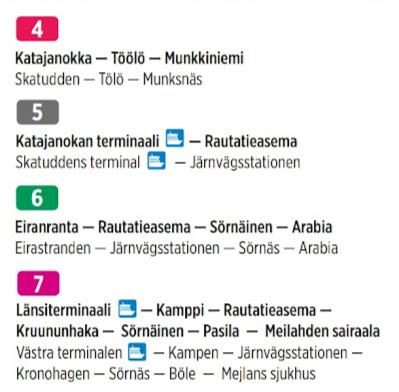Even In Winter!
The only network missing from the video above is the Metro, but as it is mostly underground, you might pyreseume that it looks the same in Winter as in Summer. There are two services on the simple network ...
... which runs from west ...... through Helsinki centre and on to the two branches in the east.
We have already met the station which connects with the new "light rail" line 15.
The western line has been recently extended and, a bit like the Elizabeth Line line, has some superb architecture.
... and a superb hanging light display display on the platform. Apparently they pulsate "to give a homely atmosphere".
fbb mansions has a homely atmosphere but his lights don't pulsate - usually!
These particular stops are very light and open ...
... with a splendid sloping ceiling.
Are the trains red or orange - memories of ...
"Strathclyde red"!Interestingly, the trains have room for bikes at both ends of the unit.
So four bike parks on a typical two unit train.
By far the main provision of transport in the central area of Helsinki is by a superb network of trams. There is no geographical tram map, so, for outsiders, matching the routes to reality is a bit of a challenge.
Note the Metro as an orange dotted line and suburban local "proper" trains show as a thin purple line.
Here is a full list of tram routes which you will almost certainly not understand.
fbb will choose a line or two to look at more closely in tomorrow's blog.
Now, here is a small selection of the trams themselves. They are mostly quite short by today's long-snake standards, which is probably why the city is so enthusiastic about using "light rail" instead of "tram" for the soon to open line 15.
But, fear not dear readers; they do have modern longer slinkier ones!
Are these very different from the stock on line 15?
Also, to complete this brief overview, there are suburban trains ...
It all looks very impressive - but how easy is it to find your way around?
Whoops!
And an email received by fbb at 1700 yesterday.
Wasn't this very expensive work meant to improve the line?



























Dawlish sea wall - The line didn't close.
ReplyDeleteI watched it both ways from the webcams - the new part was very much doing its stuff. However with a strong on shore wind, then at high tide with a storm serge, the waves hitting the wall, on the old section particularly, was throwing the spray up high which then blew across the railways. The trains were getting drenched. Cross Country knows its Voyager units won't survive that and so they stop at Exeter. Some of the GW units obviously made it, but sustained as yet unspecified damage.
I think the down side, seaward side, was not used for a while, but it is signaled so that the cliff side up line can be used both ways. As soon as the tide fell the railway was back to normal.
The seawall enhancements are not designed to allow the line to be used all the time, but to allow resumption as soon as the tide drops - that happened - it worked.
As a by-product the local road no longer floods, but the bottom of the town was covered in inches of sea foam blowing under the railway bridge where the stream and pedestrians go.
Dawlish sea wall not much good if any part of it is put out of action by adverse weather. At £80 million taxpayers would expect a better return on their investment. If you can't run a proper service on it build an inland route!
ReplyDelete